[B. M. Guide, Pl. XXVI. 37.]



[L. Müller, Numismatique de Ancienne Afrique, ii, and Supp., pp. 45 f., Cagnat, op. cit.]
Carthago (Müller, ii, pp. 66 sqq.). It is noteworthy that this wealthy commercial state, with its population of some 700,000 inhabitants, made no use whatever of coined money until the great invasion of Sicily, B.C. 410, brought her armies for the second time into contact with the Greeks. Then and not till then does it appear that the necessity arose for striking coins, and it may be assumed that the payment of the troops employed in the devastation of the flourishing Hellenic settle- ments in that island was the immediate occasion of the coinage. That the use of coined money and the art of coining were borrowed by the Carthaginians from their Greek enemies is obvious from the adoption of the Sicilian type of the head of Persephone, and from the unmistakably Greek style of the earliest Carthaginian pieces.
Some of the types appear to be characteristically Carthaginian; e. g. the palm-tree (φοινιξ), which is evidently a canting type, and the horse’s head, which seems to allude to the foundation-legend mentioned by Virgil (Aen. i. 442 ff.). Otherwise, the Punic in- scription is the only indication that these series of coins are not purely Greek, and there is every reason to think that they were struck in Sicily and not in Africa, and that Greek artists were employed to engrave the coin-dies. In several instances the names of Carthaginian towns in Sicily occur upon the coins, such as רש מלקרת, Resh Melqarth = Cephaloedium, המטוא Motya, ציץ = Panormus (?), ארך Eryx, כפרא Kfra (Kaphara, Village) = Solus. These have been already described under the cities whose names they bear (pp. 136, 139, 158, 161 f., and 170). There are, however, several other series bearing the inscriptions קרתחדשת, Qart Chadsat (= New city of Carthage); מחנת, Machanat (= the Camp); עם מחנת ,עם המחנת, or שעם מחנת, Am Machanat, Am hammachanat, or Shâm Machanat (People of the Camp); מחשבם, Mechasbim (the Quaestors), &c., which cannot be distinctly classed to any particular locality in Sicily. Such coins may therefore be appro- priately described as Siculo-Punic, that is to say, as coins struck in Sicily for the payment of the Carthaginian armies. The following are the principal varieties (see Holm, Gesch. Sic., iii, pp. 643 ff.):—
| Head of Persephone, of fine early style. [B. M. Guide, Pl. XXVI. 37.] |
Prancing horse; above AV 118 grs.
|
| Id. | Id. AV 23.8 grs.
|
| Date-palm tree (φοινιξ). | Horse’s head. AV 15.3 grs.
|
| Head of Persephone. | Date-palm tree. AV 36 grs.
|
| קרת חדשת Forepart of horse, some- times crowned by Nike. | מחנת Date-palm tree. [Holm, No. 268,
Pl. VIII. 1.]. AR Attic tetradr.
|
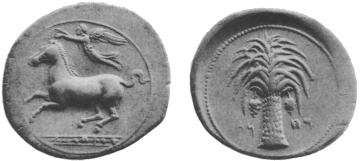
FIG. 390.
| קרת חדשת Free horse, crowned by Nike. | Date-palm tree (Fig. 390). AR Tetradr.
|
| קרת חדשת or no inscr. Head of Perse- phone, with or without dolphins around. | Free horse before palm-tree. [B. M.
Guide, Pl. XXVI. 39, and Pl. XXXV.
37, 38.]. AR Tetradr.
|
| Horse’s head. | Top of date-palm tree. AR Obol.
|
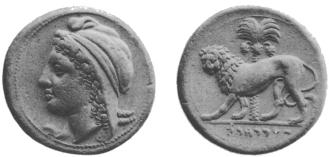
FIG. 391.
| Head of a queen, wearing tiara of Oriental form. | שעם מחנת Lion and palm-tree (Fig.
391). AR Tetradr.
|
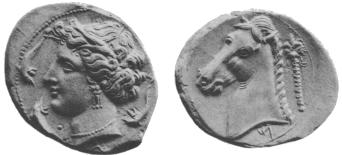
FIG. 392.
| Head of Persephone surrounded by dolphins. | עם מחנת or מ Horse’s head and palm-
tree (Fig. 392). AR Tetradr.
|
| Head of Herakles in lion-skin. | עם ה מחנת ,שעם מחנת, or מחשבם Horse’s head and palm-
tree. [B. M. Guide, Pl.
XXXV. 36.].
AR Tetradr.
|
| Head of Persephone surrounded by dolphins. | Quadriga. AR Tetradr.
|
The resemblance of the head of Herakles on the coins of this series to that on the earliest tetradrachms of Alexander the Great is a valuable indication of date.
The Siculo-Punic bronze coins of this period are not numerous.
| Head of Persephone. | Free horse. Æ .7
|
| Bust of Artemis (?). | Id. Æ .55
|
| Date-palm tree. | Pegasos. Æ .65
|
| Id. | Horse’s head. Æ .8
|
| Head of Persephone. | Horse’s head. Æ .9
|
During the reign of Agathocles of Syracuse it would seem that the issue of Carthaginian money in Sicily came to an end.
The money struck at Carthage itself consists wholly of gold (seldom pure), electrum, and bronze, down to the time of the acquisition of the rich silver mines of Spain, and the foundation of Carthago Nova in that country by Hasdrubal, the son-in-law of Hamilcar Barca, B.C. 242, when large silver coins, both Carthaginian and Hispano-Carthaginian, appear to have been first issued.
The gold and electrum money here referred to, which falls into the interval between the age of Timoleon and the end of the first Punic war, is as follows :—
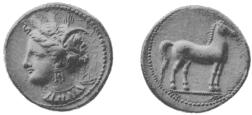
FIG. 393.
| Head of Persephone, wearing necklace with pendants. | Horse standing (Fig. 393). AV 145 grs.
|
| Id. | Horse and palm-tree. AV 73 grs.
|
| Id. | Horse standing. [B. M. Guide, Pl.
XLVII. 41.]. EL. 118 grs.
|
| Head of Persephone. | Horse and palm-tree. EL. 58 grs.
|
| Id. | Horse standing, looking back. EL. 27 grs.
|
These coins follow the Phoenician standard (drachm 59 grs.; 1½ dr. 88 grs.; didrachm 118 grs.; 2½ dr. 147 grs.). The bronze coins resemble the electrum drachms in size and types.
The period after the first Punic war is characterized by the great influx of precious metals from the newly acquired Spanish mines, and by the issue of large electrum, silver, and bronze coins. The development of style is so gradual that it is difficult to draw a line between the coins preceding and the coins following the second Punic war, although certain groups may be safely attributed to the period B.C. 241-146.
| Head of Persephone. [Num. Chron., 1899, Pl. VIII. 8.] | בארצת Prancing horse and palm-tree.
EL. 350 grs.
|
| Id. [Müller, Fig. 66.] | Horse standing, looking back.
EL. 193 grs.
|
| Id. [B. M. Guide, Pl. LIX. 33.] | Horse standing; above, radiate disk
flanked by two uraei. EL. 175 grs.
|
| Id. [B. M. Guide, Pl. LIX. 34.] | Horse standing. EL. 118 grs.
|
| Id. (flat style). | Id. EL. 46 grs.
|
| Id. | Horse and palm-tree. EL. 36 grs.
|
| Id. | Horse. AV or EL. 29 grs.
|
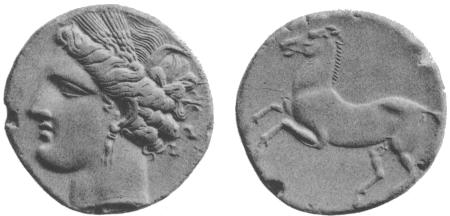
FIG. 394.
| Head of Persephone. | Prancing horse (Fig. 394).
(Dodekadrachm) AR 704 grs.
|
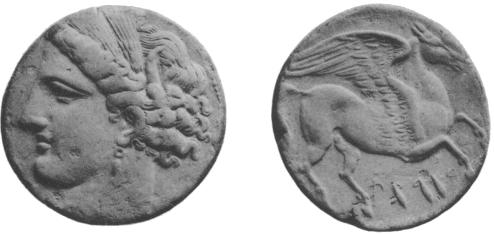
FIG. 395.
| Id. (Fig. 395). | בארצת (B'rtsth) Pegasos.
(Dekadrachm) AR 574 grs.
|
| Id. [Müller, ii, No. 128.] | Id. (Octadrachm) AR 453.4 grs.
|
| Id. [Müller, ii, Fig. 99.] | Horse standing; above, radiate disk,
flanked by two uraei.
AR 364 grs. (6 Dr.)
|
| Id. [Ibid., Fig. 129.] | Horse’s head. AR 341 grs.
|
| Id. [B. M. Guide, Pl. LIX. 36.] | Horse; above, star. AR 228 grs. (4 Dr.)
|
| Id. [B. M. Guide, Pl. XLVII. 43; LIX. 37.] | Horse and palm-tree; Horse looking
back; Horse standing or trotting.
AR various smaller denominations.
|
| Id. (serrated edge). | Horse. AR 204 grs.
|
| Id. | Horse and palm-tree. POT. 170 grs.
|
| Id. | Horse and star. POT. 44 grs.
|
The standard of the above-described coins is the Phoenician, the denominations being 12, 10, 8, 6, 4, 3, 2½, 2, 1½, 1¼, and 1 drachm, together
With the last electrum coins of Carthage of 46 grs. we may compare the contemporary electrum coins of Capua struck during the revolt of that city from Rome in the Hannibalic war (B.C. 216-211). (Supra, p. 35.) The similarity of the Capuan coins to those of Carthage in weight (46 grs.) and style, as well as in the base quality of the alloy of which they are composed, renders it highly probable that Capua, while the army of Hannibal was wintering there, B.C. 216-215 (Livy, xxiii. 18; Strabo, v. 4. 13), assimilated her coinage to that which was current among the Carthaginian troops, unless, indeed, the Capuan pieces were issued by the Carthaginians themselves. The silver Carthaginian coins with serrated edges probably belong to the same period.
The greater part of the money of Carthage towards the end of this period consists of bronze coins of very bad style and execution.
In addition to the coins certainly struck at Carthage itself there are a number of others, indistinguishable in style and type from the undoubted Carthaginian issues, which from the fact of their frequent occurrence in Spanish Finds, have been assigned to the Carthaginian possessions in Spain (see Zobel, Monatsber. d. kon. Akad. d. Wissensch., Berlin, 1863, p. 253 f.). The evidence is, however, far from conclusive (see Babelon, Rev. Num., 1889, pp. 403 f., 407 f.). Others in gold, silver, and bronze are conjecturally attributed by Müller (ii. 147) to Sardinia, after it ceased to form part of the Carthaginian dominions.
| Head of Persephone. | Bull standing; above, star; beneath,
crescent enclosing disk.
AV 59, 46.5 grs.
|
| Young male head diademed. | Bull standing; symbol, ear of corn.
AR 113 grs.
|
| Young male head diademed. | Bull standing; symbol, uraeus. AR 54 grs.
|
| Head of Persephone. | Three ears of corn, surmounted by
crescent containing disk. Æ 1.15-.9
|
| Id. | Bull standing; above, star. Æ .8
|
| Id. [Bull. Arch. du Com. des Trav., 1899, p. cciii.] | Plough. Æ .9
|
The following coins are also of uncertain mints (Müller, pp. 145, 146) :—
| Head of Athena in triple-crested helmet. [Müller, No. 4.] |
Horse standing (perhaps Spanish).
Æ 1.05
|
| Head of Apollo laureate. [Müller, No. 1.] | Horse and radiate disk, flanked by two
uraei (perhaps Sicilian). Æ 1.05
|
| Head of young Ares (?) helmeted. [Müller, No. 3.] |
Palm-tree (perhaps Spanish). Æ .8
|
| Head of Athena in crested helmet. [Müller, No. 6.] |
Horse, head reverted. Æ .75
|
Carthage was rebuilt by Julius Caesar, B.C. 45, and in B.C. 29 it was recolonized by Augustus. As a Roman colony it struck bronze coins down to the reign of Tiberius. Inscr., KAR VENERIS, Temple of Venus. Abbreviated names of the SVF[ETES] or Duumviri, also C. I. C. D. D. P. P. = Colonia Julia Carthago, decreto decurionum, permissu pro- consulis, &c. (Müller, ii, p. 149).
Clypea (Kelibia), founded by Agathocles under the name of Aspis (from the resemblance of the promontory on which it stood to a shield), was made a Roman colony in B.C. 45. Pliny describes it as liberum Clypea in promontorio Mercurii (H. N. v. 24). Nevertheless the attri- bution to it of coins of the time of Augustus and Tiberius (reading C. I. P. or C. P. I., types—Hermes, Livia as Ceres; see Müller., ii, pp. 155 f.) is improbable. See C. I. L., viii, p. 128.
Hippo (Binsert), surnamed Diarrhytus, from its position at the narrow outlet of Lake Hipponitis, was an ancient Sidonian colony dependent upon Carthage. It was made a colony probably by Julius Caesar (Col. Iulia Hippo Diarrhytus), and as a free town struck bronze coins in the reigns of Augustus and Tiberius, and perhaps also again (though this is doubtful) in that of Clodius Albinus. Inscr., HIPPONE LIBERA. Types—Head of Astarte wearing veil and stephane; Female cultus- statue to front, wearing modius, r. raised, l. holding caduceus; Head of Ceres; Head of Juno; Livia (IVL. AVG.) seated. Names of pro- consuls L. Apronius and Fabius Maximus Africanus (Bull. Arch. du Com. des Trav. Hist., 1897, pp. 250 f.; 1900, p. clxix; 1901, p. cxciii).
Utica, a Tyrian colony of great antiquity, received its freedom at the hands of the Romans after the fall of Carthage. The coins of Utica belong to the reign of Tiberius. About B.C. 36 it received the Roman citizenship; under Hadrian it became a colony. Inscr., M. M., or M. MVN. IVL. VTIC. D. D. P. P., ‘Municipes Municipii Julii Uticensis, decreto decurionum, permissu proconsulis’ (C. I. L., viii, p. 149), usually with addition of the names of the Roman Proconsuls, &c. Types—Veiled female bust (Livia?) or Head of Tiberius, rev. Livia enthroned and holding patera.
[A. Mayr, Die antiken Münzen der Inseln Malta, Gozo und Pantelleria (Progr. K. Wilhelms- Gymn., Munich, 1894).]
Cossura (Pantelleria), midway between Sicily and Africa, was inhabited by a people of Phoenician race. The island was finally taken from the Carthaginians by the Romans in B.C. 217. Its coins are all of
| Female head with Egyptian head-dress. [Mayr, Fig. 13.] |
אירנם (‘irnm) within a wreath of laurel.
Æ .8
|
| Id. crowned by Nike. [Mayr, Fig. 14.] | Id. Æ .8
|
| Similar head, with or without Nike. [Mayr, Fig. 16; Hill, Sicily, Pl. XV. 18.] |
COSSVRA within a wreath of laurel.
Æ 1.05-.8
|
For other varieties see Mayr, pp. 24 f.
Gaulos (Gozo), a small island separated from Melita by a narrow strait, was probably acquired by the Romans in B.C. 218. It contains the remains of a temple of the moon-goddess Astarte, who is represented on the coins. These are bronze of the first century B.C.; obv. Head of Astarte with crescent; rev. ΓΑΥΛΙΤΩΝ Warrior; in field, star (Mayr, Fig. 11; Hill, Sicily, Pl. XV. 16).
Melita (Malta) was taken by the Romans in B.C. 218. Bronze from this date to end of first century B.C.
| Head of Herakles; in front, caduceus. [Mayr, Fig. 1; Hill, Sicily, Pl. XV. 11.] |
אנן (‘nn) Sacrificial cap in wreath.
Æ .9-.8
|
| Veiled female head. [Mayr, Fig. 2; Hill, Pl. XV. 12.] | „ Mummy of Osiris (with flail and
sceptre) between Isis and Nephthys,
each with wings crossed in front and
wearing solar disk with horns.
Æ 1.15
|
| Id. [Mayr, Fig. 3; Hill, Pl. XV. 13.] | „ Ram’s head. Æ .75-.5
|
| Id. [Mayr, Fig. 4; Hill, Pl. XV. 14.] | אנן אנן Tripod. Æ .65
|
| ΜΕΛΙΤΑΙΩΝ Head of Isis, wearing uraeus crown; in field, ear of corn or caduceus and ankh combined. | Osiris (?), with four wings, kneeling,
wearing Egyptian crown, holding
flail and sceptre [Mayr, Fig. 5; Hill,
Pl. XV. 15]. Æ 1.05
|
| Head of Apollo. [Mayr, Fig. 6.] | ΜΕΛΙΤΑΙΩΝ Lyre. Æ .6
|
| Id. [Mayr, p. 10, No. 8.] | „ Tripod. Æ .7
|
| Veiled female head. [Mayr, Fig. 7.) | „ Lyre. Æ .6
|
| Id. [Mayr, Fig. 8.] | „ Tripod. Æ .9-.75
|
| Id. [Mayr, Fig. 10.] | MELITAS Tripod. Æ .85
|
| ΜΕΛΙΤΑΙΩΝ Veiled female head. [Mayr, Fig. 9.] |
C. ARRVNTANVS BALB PROPR
Curule chair. Æ .8
|